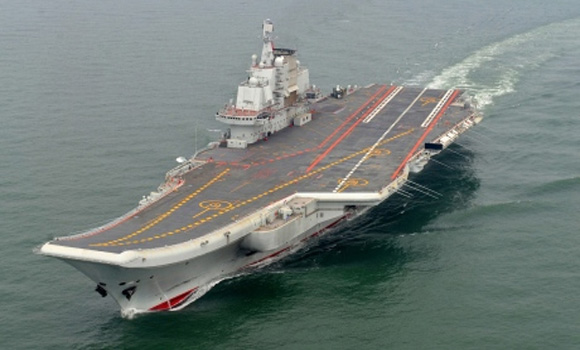The United States and China are locked in an increasingly fierce bid for military influence in the Pacific amid lingering tensions in the East China and South China seas.

Updating its global strategy, the U.S. Defense Department announced the Quadrennial Defense Review (QDR) on Tuesday, which calls for deploying more naval vessels to the Pacific.
On Wednesday, the Chinese government unveiled a record defense budget for 2014. The country is steadily building up its military strength to counter the U.S. military’s “pivot” to Asia and to forge a relationship of equals with the U.S.
The increasingly tough competition between the U.S. and China for military influence in the region will also have a significant impact on Japan’s security.
New strategies
After ending its wars in Afghanistan and Iraq, the U.S. is poised to implement, in earnest, a strategy aimed at countering China’s growing military presence in the Pacific.
The latest QDR, which serves as the basic guideline for the Pentagon’s military strategy, calls for boosting deployment levels of its naval assets in the Pacific from 50% to 60% by 2020.
China is pursuing a strategy in the Pacific dubbed Anti-Access/Area Denial (A2/AD). This strategy is based on China’s two conceptual lines of defense against the U.S.
The latest QDR refers to these emerging A2/AD challenges, although it stops short of naming China. But it is clear that the U.S. plan to build up its naval presence in the Pacific is aimed at countering China’s growing presence there.
The new QDR also comes amid growing fears of an accidental clash in Asian waters.
Japan, a key U.S. ally in Asia, is facing unilateral provocations from China in the East China Sea, which is home to the Senkaku Islands, or the Diaoyu Islands as China calls them.
The Philippines, another U.S. ally, is also facing a similar situation in the South China Sea.
By setting a numerical target for the U.S. naval presence in the Pacific, Washington is issuing a thinly veiled warning to Beijing over China’s aggressive maritime activities in the East China and South China seas.
Pitching in
The new QDR also shows how difficult the U.S.’s financial conditions are.
There are lessons to be learned from the administration of former President George W. Bush, who lost public support after the wars in Iraq and Afghanistan weighed on the U.S. economy.
The U.S.’s basic future strategy in Asia will be to cope with security challenges posed by China while promoting burden-sharing with regional allies such as Japan, South Korea and Australia.
This expectation of increased cooperation is particularly strong toward Japan. The new QDR specifies that the U.S.’s critical naval presence in Japan needs to be enhanced. This statement can be seen as a request that Japan expand its scope of cooperation between its Self-Defense Forces and the U.S. military.
Immediately before the new QDR was released, Russia launched a military intervention in the southern Ukrainian region of Crimea, raising concerns about tensions between the U.S. and Russia.
The situation in the Middle East is also becoming more tense than usual. There is no guarantee that the new U.S. defense strategy, as outlined in the latest QDR, will go ahead smoothly.
China’s military buildup
Chinese Premier Li Keqiang delivered a government work report at the opening of the annual session of the National People’s Congress, the nation’s parliament, on Wednesday. In the report, Li made clear China’s policy of further modernizing its military. He said that China will enhance the combat readiness of its military and make efforts to develop high-tech weapons and equipment.
China has been putting a particular emphasis on its navy, air force and Second Artillery Corps, which is the strategic missile division.
Beijing sees the expansion of its state-of-the-art weaponry, including its aircraft carrier, stealth fighter jets, submarines and ballistic missiles, as crucial to its efforts to prevent U.S. forces deployed in the Pacific from approaching mainland China.
The Chinese military has drawn two conceptual lines of defense against the U.S. — the “First Island Chain,” which stretches from Okinawa’s main island to the South China Sea, and the “Second Island Chain,” which links Tokyo to Guam and other places.
China’s navy has already placed most of the waters inside the First Island Chain under its sphere of influence and has also stepped up military exercises in the western Pacific in recent years.
According to Chinese media, the Chinese navy conducted military drills in the western Pacific nine times in 2013, compared with a total of 21 drills during the previous six years of 2007 to 2012.
It is now common for Chinese naval vessels to sail beyond the Second Island Chain. “We dispatch intelligence-gathering vessels to waters off the coast of Hawaii to collect electronic intelligence from the U.S. Pacific Fleet,” a Chinese military source said.
China shows no sign of backing away from its growing assertiveness in disputed waters in the East China and South China seas, as it is testing the waters to see how the U.S. will respond to issues in the Pacific.
During an official visit to the U.S. last June, Chinese President Xi Jinping reportedly told President Barack Obama, “The vast Pacific Ocean has enough space for the two large countries of China and the U.S.”
Xi’s remark is widely seen as reflecting China’s ambition to have its own part to play in the Pacific.



Simply put, China no longer entertains US’s military double standard and their constant global instigation ; neither is Russia.